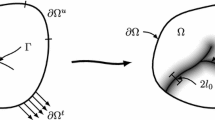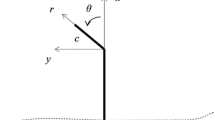Abstract
Size-effects characterize the fracture process of many engineering materials. Their modelling calls for material constitutive relations which are not indifferent, as standard elasticity, to variations of scale: strain-gradient elasticity or plasticity have often served the purpose.
The three classical crack opening problems of fracture mechanics are here solved within the framework of linear strain-gradient elasticity for the most general isotropic material. Apart from the Lamé constants, this is completely identified by five additional moduli, modelling its micro-structural characteristics. This general setting allows for recovering, as particular cases, previous analyses in (Gourgiotis and Geogiadis in J. Mech. Phys. Solids 57(11): 1898–1920, 2009), relative to modes I and II for the so-called Simplified Mindlin materials (17), and in (Radi in Int. J. Solids Struct. 45(10): 3033–3058, 2008), relative to mode III for couple-stress materials. More importantly, having a rather refined material description allows for understanding how the energy release rate is affected by the actual values of the characteristic lengths. Hence we demonstrate the strengthening effect of suitable microstructures and their optimality in order to provide cohesive like actions on the crack lips.
Despite being limited to the linear elastic hypothesis, the solutions found constitute an useful insight to develop more complex, possibly nonlinear, constitutive relationships for the strain-gradient terms as for plastic or viscoelastic materials.












Similar content being viewed by others
Notes
The shearing mode (44) could be treated similarly.
References
Anthoine, A.: Inertie de flexion d’une section circulaire selon la thèorie du second gradient. C. R. Acad. Sci., Sér. 2, Méc. Phys. Chim. Astron. 326(4), 233–236 (1998)
Aravas, N., Giannakopoulos, A.E.: Plane asymptotic crack-tip solutions in gradient elasticity. Int. J. Solids Struct. 46(25–26), 4478–4503 (2009)
Bailey, N.P., Sethna, J.P.: Macroscopic measure of the cohesive length scale: fracture of notched single-crystal silicon. Phys. Rev. B 68, 205204 (2003)
Barenblatt, G.I.: The mathematical theory of equilibrium cracks in brittle fracture. Adv. Appl. Mech. 7, 55–129 (1962)
Begley, M.R., Hutchinson, J.W.: The mechanics of size-dependent indentation. J. Mech. Phys. Solids 46(10), 2049–2068 (1998)
Bigoni, D., Drugan, W.J.: Analytical derivation of Cosserat moduli via homogenization of heterogeneous elastic materials. J. Appl. Mech. 74(4), 741 (2007)
Bouchaud, E.: Scaling properties of cracks. J. Phys. Condens. Matter 9, 4319–4344 (1997)
Bouchaud, E., Boivin, D., Pouchou, J.L., Bonamy, D., Poon, B., Ravichandran, G.: Fracture through cavitation in a metallic glass. Europhys. Lett. 83(6), 66006 (2008)
Bouchbinder, E., Livne, A., Fineberg, J.: The 1/r singularity in weakly nonlinear fracture mechanics. J. Mech. Phys. Solids 57, 1568–1577 (2009)
Bourdin, B., Francfort, G., Marigo, J.J.: Numerical experiments in revised brittle fracture. J. Mech. Phys. Solids 48, 797–826 (2000)
Bourdin, B., Francfort, G.A., Marigo, J.-J.: The variational approach to fracture. J. Elast. 91(1–3), 5–148 (2008)
Célarié, F., Prades, S., Bonamy, D., Ferrero, L., Bouchaud, E., Guillot, C., Marlière, C.: Glass breaks like metal, but at the nanometer scale. Phys. Rev. Lett. 90(7), 075504 (2003)
Dell’Isola, F., Sciarra, G., Vidoli, S.: Generalized Hooke’s law for isotropic second gradient materials. Proc. R. Soc., Math. Phys. Eng. Sci. 465(2107), 2177–2196 (2009)
Drugan, W.J., Willis, J.R.: A micromechanics-based nonlocal constitutive equation and estimates of representative volume element size for elastic composites. J. Mech. Phys. Solids 44(4), 497–524 (1996)
Eshel, N.N., Rosenfeld, G.: Effects of strain-gradient on the stress-concentration at a cylindrical hole in a field of uniaxial tension. J. Eng. Math. 4, 97–111 (1970)
Fleck, N.A., Hutchinson, J.W.: A reformulation of strain gradient plasticity. J. Mech. Phys. Solids 49(10), 2245–2271 (2001)
Gao, H., Rice, J.R.: A first-order perturbation analysis of crack trapping by arrays of obstacles. J. Appl. Mech. 111, 828–836 (1989)
Georgiadis, H.G., Vardoulakis, I.: Anti-plane shear Lamb’s problem treated by gradient elasticity with surface energy. Wave Motion 28, 353–366 (1998)
Germain, P.: La méthode des puissances virtuelles en mécanique des milieux continus. I. Théorie du second gradient. J. Méc. 12, 235–274 (1973)
Gourgiotis, P., Sifnaiou, M., Georgiadis, H.: The problem of sharp notch in microstructured solids governed by dipolar gradient elasticity. Int. J. Fract. 166(1–2), 179–201 (2010)
Gourgiotis, P.A., Georgiadis, H.G.: Distributed dislocation approach for cracks in couple-stress elasticity: shear modes. Int. J. Fract. 147, 83–102 (2007)
Gourgiotis, P.A., Georgiadis, H.G.: Plane-strain crack problems in microstructured solids governed by dipolar gradient elasticity. J. Mech. Phys. Solids 57(11), 1898–1920 (2009)
Han, K., Ciccotti, M., Roux, S.: Measuring nanoscale stress intensity factors with an atomic force microscope. Europhys. Lett. 89(6), 66003 (2010)
Hori, M., Nemat-Nasser, S.: Interacting micro-cracks near the tip in the process zone of a macro-crack. J. Mech. Phys. Solids 35, 601–629 (1987)
Huang, Y., Xue, Z., Gao, H., Nix, W.D., Xia, Z.C.: A study of microindentation hardness tests by mechanism-based strain gradient plasticity. J. Mater. Res. 15(8), 1786–1796 (2000)
Hui, C.Y., Ruina, A.: Why k? High order singularities and small scale yielding. Int. J. Fract. 72, 97–120 (1995)
Lakes, R.S.: Experimental microelasticity of two porous solids. Int. J. Solids Struct. 22, 55–63 (1986)
Lakes, R.S.: Experimental methods for study of Cosserat elastic solids and other generalized elastic continua. In: Muhlhaus, H. (ed.) Continuum Models for Materials with Micro-Structure. Wiley, New York (1995)
Lazar, M., Maugin, G.A.: Nonsingular stress and strain fields of dislocations and disclinations in first strain gradient elasticity. Int. J. Eng. Sci. 43(13–14), 1157–1184 (2005)
Mindlin, R.D.: Micro-structure in linear elasticity. Arch. Ration. Mech. Anal. 16, 51–78 (1964)
Mindlin, R.D., Eshel, N.N.: On first-gradient theories in linear elasticity. Int. J. Solids Struct. 4, 109–124 (1968)
Pijaudier-Cabot, G., Bazant, Z.P.: Non local damage theory. J. Eng. Mech. 113(10), 1512–1533 (1987)
Podio-Guidugli, P., Vianello, M.: Hypertractions and hyperstresses convey the same mechanical information. Contin. Mech. Thermodyn. 22(3), 163–176 (2010)
Radi, E.: On the effects of characteristic lengths in bending and torsion on Mode III crack in couple stress elasticity. Int. J. Solids Struct. 45(10), 3033–3058 (2008)
Schmittbuhl, J., Roux, S., Vilotte, J.P., Maloy, K.J.: Interfacial crack pinning: effect of nonlocal interactions. Phys. Rev. Lett. 74(10), 1787–1790 (1995)
Sciarra, G., Vidoli, S.: The role of edge forces in conservation laws and energy release rates of strain-gradient solids. Math. Mech. Solids 17(3), 266–278 (2011)
Shen, B., Paulino, G.H.: Direct extraction of cohesive fracture properties from digital image correlation: a hybrid inverse technique. Exp. Mech. 51, 143–163 (2011)
Sokolowski, M.: Theory of Couple-Stresses in Bodies with Constrained Rotations. CISM Courses and Lectures, vol. 26. Springer, Berlin (1972)
van Mier, J.G.M., van Vliet, M.R.A.: Uniaxial tension test for the determination of fracture parameters of concrete: state of the art. Eng. Fract. Mech. 69, 235–247 (2002)
Williams, M.L.: Stress singularities resulting from various boundary conditions in angular corners of plates in extension. J. Appl. Mech. 74, 526–528 (1952)
Zhang, L., Huang, Y., Chen, J.Y., Hwang, K.C.: The mode iii full-field solution in elastic materials with strain gradient effects. Int. J. Fract. 92(4), 325–348 (1998)
Author information
Authors and Affiliations
Corresponding author
Appendices
Appendix A
As suggested by Fig. 1 the actual crack opening displacement (COD) results from a matching between the asymptotic solution (37), which on the upper lip θ=π, reads:
and the far-field solution suitably shifted by a distance b; this last, again on the lip θ=π, reads \(w_{f}(r) \propto K_{I\!\!I\! \!I} \sqrt{r-b}\). We estimate the distance d by asking the C 1 continuity between the two CODs and the equality of the strain and strain-gradient energies. These requests are tantamount to solve the three equations:
in the three unknowns d, b and C III /K III ; here ψ 1 and ψ 2 account respectively for the strain and strain-gradient energy densities. For the antiplane case one easily obtain:
which is plotted in Fig. 4. A similar reasoning allows to estimate d for the inplane and shear opening modes, see Fig. 5.
Appendix B
We report the expression for the constants in (44), (45) and (45), together with their specialization to couple-stress materials (15) and to Simplified Mindlin materials (17). In particular, the k constants in Eqs. (44)–(45) are:

with

The expressions for the J-integral in (57) are:



where \(\varDelta = (5 \ell_{e}^{2}+3 \ell_{s}^{2} )^{2} (9 \ell_{b}^{2}+24 \gamma_{3}+16 (\ell_{e}^{2}-9 \ell_{s}^{2} ) ) (-15 \ell_{b}^{2}+40 \gamma_{3}+16 (\ell_{e}^{2}+15 \ell_{s}^{2} ) )^{2}\).
For the constitutive case (15), Eqs. (63) reduce to:

while clearly J 22=J 24=J 44=0 as ℓ e =0 in (15).
For the SM materials (17), Eqs. (63) reduce to:

while

Rights and permissions
About this article
Cite this article
Sciarra, G., Vidoli, S. Asymptotic Fracture Modes in Strain-Gradient Elasticity: Size Effects and Characteristic Lengths for Isotropic Materials. J Elast 113, 27–53 (2013). https://doi.org/10.1007/s10659-012-9409-y
Received:
Published:
Issue Date:
DOI: https://doi.org/10.1007/s10659-012-9409-y




